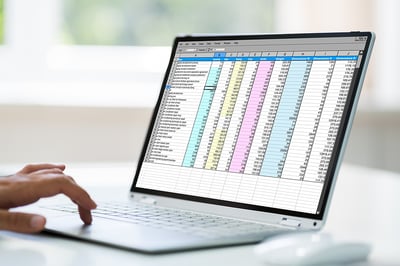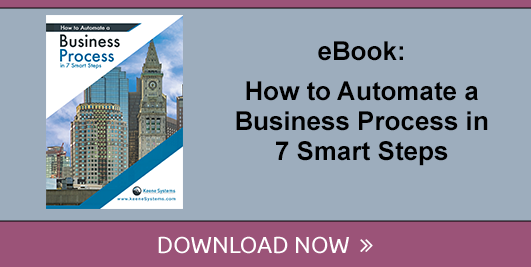Convert Spreadsheets into Business Web Apps | Keene Systems
4 min read
Topic:
Automate Business Process
In a lot of situations, businesses are still using spreadsheets as a database to capture key intelligence and other information - which is a decision that certainly brings with it its fair share of challenges.
More often than not, once the data is entered into a spreadsheet it tends to stay there, creating a data silo when you can't afford to be dealing with one. The people who need access to that information simply don't have it (and may not actually be aware that it exists), limiting the amount of insight that anyone is able to draw from it.
But thankfully, there is a better alternative and it's a lot easier to take advantage of than you might think. By documenting the needs of your organization, you can create a web application that can capture, retrieve and display data at a moment's notice. This brings with it the most important benefit of all: guaranteeing that all employees have access to the data they need to efficiently do their jobs, no matter what.
Let Understanding and Insight Be Your Guide
 By far, one of the most important things for you to understand when converting spreadsheets into business web applications is that there really is no "one size fits all" approach to what you're doing. Indeed, that's one of the major reasons why using spreadsheets as a database is so limiting in the first place - it's an approach that essentially requires you to act as if all data is created equally, when that really couldn't be farther from the truth.
By far, one of the most important things for you to understand when converting spreadsheets into business web applications is that there really is no "one size fits all" approach to what you're doing. Indeed, that's one of the major reasons why using spreadsheets as a database is so limiting in the first place - it's an approach that essentially requires you to act as if all data is created equally, when that really couldn't be farther from the truth.
Therefore, the first thing you need to do is make a meaningful effort to understand what the data in your spreadsheet is actually being used for. Who needs to have access to it? Why do they need access to it? Where, specifically, will they need to draw upon this data to do their important jobs on a daily basis?
These are all questions that will have unique answers depending on the circumstances, and they're all ones that you will need to answer before the remainder of the process can begin in earnest.
Building a Genuine Workflow
Next, it's critical to understand another one of the reasons why using spreadsheets as databases is ultimately so inadequate - they typically do not provide anything in the way of a real, genuine workflow.
At its core, a workflow is a sequence of tasks that are required to process a set of data. Any time data is passed from one employee to the next, or from one system to the next, a workflow is created. In other words, it's the set of steps required to take your data and move it from its initial raw state and into a processed form that you can actually work with.
Spreadsheets don't support these types of workflows simply because they were never really designed to - this despite the fact that a lot of people seem to use them that way. Because of this, when converting spreadsheets into business web applications, you need to document the flow of data through the organization as well as possible. You need to understand (and document) who needs that information where, when and why - all so that the business web application can support and empower this workflow instead of artificially limit it as your spreadsheet has been doing all this time.
Capturing Data Organically
Based on specifically what data is in the spreadsheet, you can then design a database that can capture that information as accurately as possible. This is the key step towards moving away from those "old school" spreadsheets and into the world of business process automation. Once you understand the relationships between the different sheets and calculations, you can design a database that can capture that data with the speed, efficiency and accuracy that you need.
Along the same lines, you'll need to identify data validation rules to make sure that the information in question cannot be corrupted. In a lot of ways, these rules alone make the system so much more robust than a simple spreadsheet could ever be because you're not just storing data, you're also confirming the validity of it before it moves elsewhere across your organization. Never forget that spreadsheets are fallible in large part because they're so subject to human error. The value of the insight you're able to extract from that data literally depends on accurate, actionable information to work from in the first place.
By making sure that the information in the business web application cannot be corrupted, you're immediately putting yourself in a position to do more with that data than a spreadsheet alone would ever allow.
During this process, you'll also want to design a series of screens that would allow a user - any user - to enter and edit data. Other screens should also be designed to display that data, such as reports or custom dashboards.
This approach brings with it a number of key benefits, essentially all at the exact same time. By designing screens that are built to allow users to quickly enter and edit data, you're immediately creating a user experience that is far more satisfying than a simple spreadsheet. By streamlining the process of entering that data, you're going a long way towards eliminating the possibility that people will be making costly mistakes at all.
By going one step further and creating a way to display and visualize that data, you're also making it possible for absolutely anyone in your organization to derive value from it. Rather than forcing them to wade through countless cells and columns on a spreadsheet, everything they need to make better and more informed decisions is right at their fingertips by way of a custom dashboard that brings the information that matters most to them front and center.
Spreadsheets don't come anywhere near this level of customization, which is a big part of why they're so ill equipped to provide you with what you need.

Testing, Training and Beyond
As you continue to convert your spreadsheets into business web applications, it's important to understand that with bigger systems in particular, your data can be imported directly into the database itself. Typically, the data import process will happen at least twice - once during the testing phase and then a final time before the application goes live to all users.
Speaking of the testing phase, it's important to have users actually road test the new system by entering new data first into the system, and then into the spreadsheet. With this approach, they can easily compare the results to guarantee accuracy and data integrity across the board.
Once you're at that point, all that is left to do is to train your users to make sure they understand not only what this new business web application can do, but why it's a legitimately better option than the spreadsheets they're used to working with. Then, you can bring the system live and start immediately enjoying the benefits that business process automation has to offer.
In the End - It's Best to Convert Spreadsheets into a Business App
Yes, it's true that the process of converting spreadsheet-based business systems into a web-based business application is a somewhat involved and time-consuming one - but it's also one that sets you and your employees up for a tremendous amount of success in the future.
Not only does it guarantee the accuracy and the performance of the final system, but a web application itself also enables your business to have access to the system anywhere, anytime and from any device. This is particularly important for not only people who will be working from home indefinitely, but for staff members in the field as well.
To learn more about the importance of eliminating human error in your operations, please download the eBook titled "How to Automate Business Process in 7 Smart Steps."

